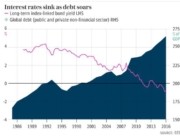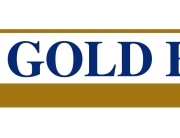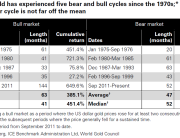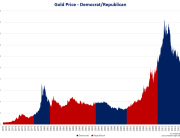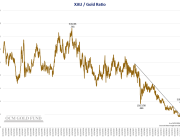The European Central Bank (ECB) finally delivered on its intention to join the QE parade by confirming it will print $60 billion euros per month. Prompting the Financial Times in an op-ed piece by John Plender to reiterate our line of reasoning by proclaiming gold may not be so crazy an idea in light of central bank policies. “Unconventional central bank policies have thoroughly distorted markets. Nobody can be sure that the central bankers will find a way out of this uncharted monetary maze without precipitating financial chaos. All we do know is that the recent experiment with forward guidance showed with painful clarity how little central bankers understand about the workings of the post-crisis economy . . .Yet gold is a fickle mistress. Without the underpin of a yield, the price can be volatile. And for all its current attractions, it unmistakably belongs to the world of least-bad options.” (Plender)
We have also maintained that war is taking place on a number of fronts with the U.S. dollar being used as the weapon of mass destruction. A good quote from a recent Bloomberg article confirming the same from Eurasia Group’s Ian Bremmer, “If you look at what we call the weaponization of finance, the U.S. dollar has been a much stronger lever of American power internationally than our combat forces have been over the course of the past couple of years.” (Bremmer) Obviously, if the USD is the weapon, the other side will look to find its weakness in order to limit its effectiveness or attempt to wipe it out entirely.
The recent election of Alexis Tsipras in Greece with his leftist ideals has cast doubt once again on the future of the euro bloc. Mr. Tsipras ran on promises of renouncing a portion of Greece’s debt, hiring 12,000 more public workers and reversing austerity programs put in place to satisfy two earlier bailouts over the past five years. Tsipras’s election is a reflection of the populist push-back in the southern euro-zone against what it views as the heavy hand of its northern brethren. Any hint of success by Tsipras of extracting debt and budget relief from its northern creditors will surely be grounds for uprisings in Italy, Portugal and Spain for the same. The technical chart break-out in the euro gold price may be giving a hint of what is to come.
Since January 14th global gold exchange traded funds have seen inflows of approximately 2.4 million ounces or 127,000 per day. With the large movement of bullion from West to East over the past two years, the London market may find it difficult to source and settle gold for exchange traded funds going forward should capital flows into gold ETF’s revert to 2011 levels. Additionally, the growing suspicion surrounding the paper gold market and the prospect of multiple claims on vaulted gold is evident by the increasing move by central banks within Europe to repatriate gold reserves from gold housed in London and New York. Part of our theory for revaluation of gold mining shares to historical multiples, besides a demonstration of capital discipline and operational execution, will be investors’ desire to be close to the “source” and a greater appreciation for gold reserves in the ground. Some appreciation showed up in January as through the end of the month as precious metal mutual funds, as per Morningstar, were some of the best performers so far in 2015, albeit coming off three pretty wretched years.

